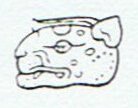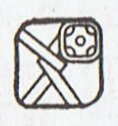Next page:
I have not listed the left part of
Gb3-14 as viri in my glyph catalogue, but will do so now. The bird
looks as if released from the 'knee' of a special kind of viri:
 |
 |
 |
 |
 |
 |
|
Ga1-18 |
Ga1-26 |
Ga5-8 |
Ga5-11 |
Ga6-19 |
Ga7-1 |
 |
 |
 |
 |
 |
|
|
Gb1-6 |
Gb2-16 |
Gb2-21 |
Gb3-14 |
Gb7-18 |
Gb2-21
looks like the top of Gb1-6. But it has 6 + 5 = 11 'feathers'
(instead of 9 + 9) and it is shallow like Gb3-14.
 |
27 |
 |
|
Gb2-21 (277) |
Gb3-14 (305) |
|
29 |
Gb2-23 has
at left and right twin 'flames' somewhat like the curious haati
in Gb3-14:
 |
 |
 |
 |
 |
 |
 |
|
Gb2-19 |
Gb2-20 |
Gb2-21 |
Gb2-22 |
Gb2-23 |
Gb2-24 |
Gb2-25 |
The little sun disc
is the 'wave crest' ('knee cap') released, and from there a tao canoe
comes. I have Gb2-21listed also as an example of tapa mea (a
reversed double such), and it may signify the darkness coming after the
double inversed haati:
 |
 |
29 |
 |
|
Gb1-16 |
Gb1-17 (247) |
Gb2-21 (277) |
From the 'center of
gravity' of Gb1-16--17 to Gb2-21 there are 30½ days. Adding another period
of 30½ days we reach to 306½:
 |
 |
 |
 |
|
Gb3-12 |
Gb3-13 |
Gb3-14 |
Gb3-15 (306) |
 |
 |
 |
 |
|
Gb3-16 (307) |
Gb3-17 |
Gb3-18 |
Gb3-19 |
 |
 |
 |
 |
|
Gb3-20 |
Gb3-21 |
Gb3-22 |
Gb3-23 |
The 'insect' in
Gb3-16 could be a description of the dry spirit rising towards the sky.
These 12 glyphs may depict how moe (Gb3-12) evolves into hua
(Gb3-23).
Counting beyond 59
(at Gb3-14) we will reach 10 * 31 = 310 at Gb3-19 (64 = 8 * 8):
 |
 |
29 |
 |
27 |
 |
|
Gb1-16 (246) |
Gb1-17 |
Gb2-21 |
Gb3-14 (305) |
|
59 |
 |
 |
 |
 |
 |
|
Gb3-15 |
Gb3-16 |
Gb3-17 |
Gb3-18 |
Gb3-19 |
| 60 |
61 |
62 |
63 |
64 |
Gb3-15 (honu)
is number 60 beyond Gb1-16, a sun number, and honu 'owns the fire'.
Like the Jaguar in South America he can loose his 'eyes', however - there is
a great hole in him. The turtle is like his counterpart in South America at
home both on land and in the water, an amphibious creature. They seem to be
at home also in the sky:
|
 |
1
Pop |
 |
|
"... there is no
dispute about the jaguar as patron of Pop ..." |
|
 |
|
According to Gates
the quincunx symbol (upper right symbol) means 'yellow', which
makes sense because in the center of the 4 cardinal stones there
ought to be a fire. Although in the inscription variant the
central fire is missing. I connect this sign with the symbol
immediately below, which looks like a shell with concave side
down (the fire is inside and not visible). The corresponding
symbol in the codices example confirms the impression of there
being a shell at bottom right. |
|
The other main
element in the Pop glyphs apparently is two intertwined
ropes. At the beginning of the year the old and new years ought
to be securely connected, I think, the 'binding of the years'.
Pop is Yucatec for 'mat' - an artifact characterized by
intertwined threads (or similar). "Pop (po
reduplicated) is widely spread in Mayan languages as the word
for 'mat'."

These pictures
show how mats are woven on hand looms by women (the moon I
guess, because at new year sun and moon should meet). The two
pictures at right have a 'tree' attached to the loom, and the
'tree' has two 'stems' which are bound together, which I believe
alludes to the binding together of the old and new years. The
idea of binding together years is close to the old 'threadreel'
symbol in the old Chinese glyph for 5. A 'mat' is manufactured
in order to let the king 'sit on' it. The idea of a net or mat
at the end of the journey seems to be universal in old human
cultures, as for instance in this ancient Egyptian picture (from
Wilkinson):

At right the
'prow' of the Pharaoh 'ship' is entering the 'mat'. |
|
The jaguar,
finally, once 'owned the fire' (I remember), but then his fire
was stolen (at least in South America). And then he lost his
fiery eyes in a juggling contest - they became hanging high up
in a tree. Instead he received small ones made from water, by
which he could see in the night. The jaguar is 'strongly
associated with the presence of water and is notable, along with
the tiger, as a feline that enjoys swimming'. The big cat Leo is
high in summer ('fire') - north of the equater. South of the
equator he is located down in the 'water' (the dark half of the
year). We can understand why there are sea-shells at bottom
right in the Pop glyphs.
The eye of the
jaguar, as depicted in the picture from the monuments, has a
horizontal line across it, which presumably indicates the water
surface (or water by pars pro toto). Higher up we can see
another 'eye', which may illustrate an 'eye' up in the 'tree'.
Sun sometimes is low ('in the water') and sometimes is high ('in
the top of the tree'). The Pop jaguar is at the low sun
stage. |
At Hua Reva the sun juggles
with his eye and looses it. The dark cloth has come in the form of a 'mat'
which the moon goddess is
weaving in order to let the sun king 'sit on':
 |
 |
 |
 |
|
Aa1-9 |
Aa1-10 |
Aa1-11 |
Aa1-12 |
The shuttle she is using probably
corresponds to tao. It carries the 'fire':
 |
 |
 |
 |
 |
 |
|
Ga1-22 |
Ga1-25 |
Ga5-10 |
Ga6-9 |
Ga7-14 |
Ga7-19 |
 |
 |
 |
 |
 |
 |
|
Ga8-19 |
Gb1-24 |
Gb2-12 |
Gb2-22 |
Gb2-23 |
Gb4-28 |
 |
 |
 |
 |
 |
 |
|
Gb2-32 |
Gb2-35 |
Gb3-2 |
Gb7-17 |
Gb7-23 |
Gb8-4 |























